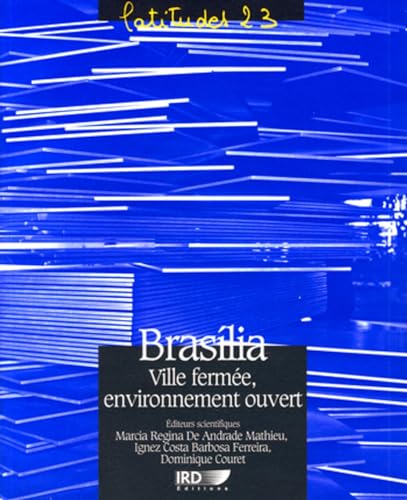Items related to Brasilia ville fermée, environnement ouvert

- PublisherIRD
- Publication date2011
- ISBN 10 2709916053
- ISBN 13 9782709916059
- BindingPaperback
- Number of pages216
Buy New
Learn more about this copy
Shipping:
FREE
Within U.S.A.
Top Search Results from the AbeBooks Marketplace
Brasilia, ville fermà ©e, environnement ouvert (French Edition) [FRENCH LANGUAGE - Soft Cover ]
Book Description Soft Cover. Condition: new. Seller Inventory # 9782709916059
BRASILIA. VILLE FERMEE. ENVIRONNEMENT OUVERT
Book Description Paperback. Condition: NEUF. Brasilía a incarné la ville moderne avant-gardiste et idéale des années 1950. Ce projet utopique, confié à un urbaniste, Lucio Costa, et un architecte, Oscar Niemeyer, résiste au temps car, près d un demi-siècle après sa fondation, la ville jouit toujours d une aura puissante. L Unesco a classé le site patrimoine mondial de l humanité en 1987 mais Brasilía est aujourd hui au coeur d une agglomération de trois millions d habitants d une incroyable vitalité. Elle surprend par sa composition spatiale distendue, dispersée et répétitive, sa communication urbaine essentiellement automobile et une apparente et inquiétante anomie sociale. Mais où donc et sous quelle forme les populations de Brasilía font-elles aujourd hui société ? Comment d un projet de ville délimitée et finie a-t-on pu aboutir à une telle urbanisation diffuse et ségréguée de l environnement régional ? Les auteurs de cet ouvrage proposent une analyse de cette expérience urbanistique et sociale unique, et s interrogent sur le sens du développement local et le dilemme urbain du XXIe siècle entre libéralisme inégalitaire et projet social régulateur. Brasíla encarnou a cidade moderna, avanguardista e ideal dos anos 1950. Este projeto utopico, confiado ao urbanista Lucio Costa e ao arquieto Oscar Niemeyer, resiste ao tempo apos meio-século de sua fundação, pois a cidade continua a possuir una auréola potente, que fascina ou repulsa o visitante. A UNESCO, a classificou Patrimônio da Humanidade em 1987, porém Brasíla é hoje o coração de uma aglomeração urbana de 3 milhões de habitantes que apresenta una incrível vitalidade. Ela surprende por sua composição espacial descontínua, dispersa e repetitiva, por sua comuniçacão urbana essencialmente calcada no automõvel e por una aparente e inquietante anomia social. Mas em que lugar e sobre qual modo as populações de Brasíla forman atualmente una sociedade ? Como um projeto de cidade delimitada e acabada pôde chegar a uma urbanização difusa e segregada do meio-ambiente regional ? Portanto, planos foram elabarados para congregar todos no seio da cidade. um verdadeiro espaço público de encontros urbanos heterogêneos existia no momento mesmo da fundação urbana de Brasíla, nos canteiros de obras, nos acampamentos. Os autores desta obra propõem uma analise desta experiência urbanística e social única e interrogam-se sobre o sentido do desenvolvimento local e do dilema do século XXI, que oscilam entre liberalismo fator de desigualdades e projeto social regulador. From its inauguration in 1960 to its registration by the UNESCO in the World Heritage List in 1987, Brasilia has been the universal materialization of the project of the modern city: avant-garde and ideal. Nowadays it has become an urban concentration of 3 million inhabitants, vast and fragmented. It surprises by its sprawl, its widespread and repetitive spatial patterns, its urban networks relying mostly on automobile, its residential enclosure and the huge gap between the social classes - the poorest bearing the burden of an unequal access to centrality and development. Yet, at its foundation it was meant as a true public locus of urban encounter, on its building site as well as its workers settlements. Nowadays where and how do the populations of Brasilia develop an integrated society? How could a project of an integrated city, delimited, with its own boundaries, conceived as the melting pot, turn into such a fragmented society, with a widening gap between the social classes, a widespread urbanisation and an environment far too open to individual housing initiatives? Could this urban and social shift of Brasilia, from a closed city, product of a totally utopian ideal of social integration, to an open and segregated city, be interpreted as an exemplary testimony of the primacy of economic dynamics over urban designs? From an urban environmental perspective, crossing Brazilian and French urban geographies, the authors address the crucial question of the conservation of Human Heritage represented by Brasilia s inner city and the multiple risks the agglomeration has - Nombre de page(s) : 1 vol. (216 p.-5 p. - Poids : 0g - Langue : fre - Genre : Tourisme Amérique du nord / du sud livres Latitudes 23. Seller Inventory # N9782709916059

